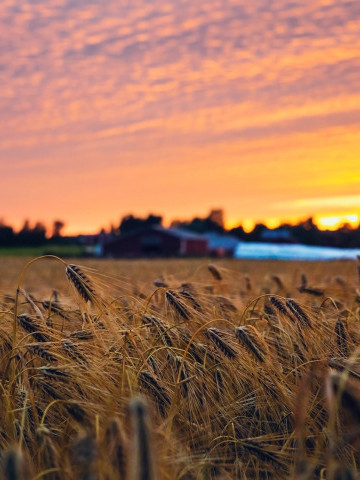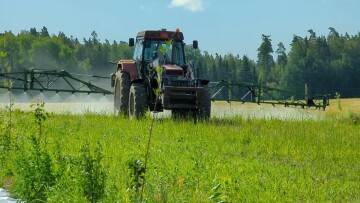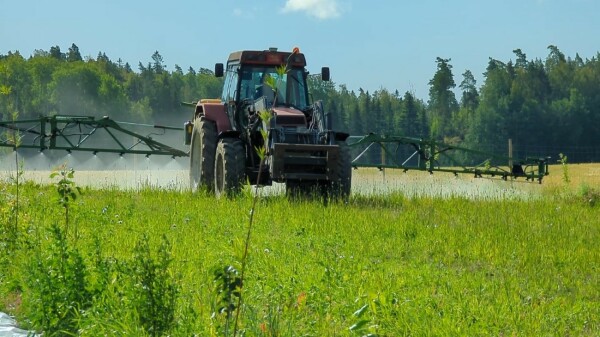
Bioekonomi
I bloggen Bioekonomi får du veta mer om Yrkeshögskolan Novias forsknings-, utvecklings- och innovationsverksamhet inom forskningsområdet systemomställning för att bygga resiliens. Majoriteten av personalen finns huvudsakligen i Raseborg. Här bildar forskare, projektarbetare, lärare, studerande och administrativ personal en dynamisk helhet. På vår blogg kan du läsa om vilka vi är, vad vi gör och om våra resultat. Välkommen!
Vid frågor eller feedback kontakta bloggens administratör Heidi Barman-Geust (Heidi.barman-geust(a)novia.fi)
Vi följer CC BY 4.0 om inget annat nämns.
Systemic Transformation to Build Resilience is one of Novia University of Applied Sciences six' research areas. The activity is mostly located in Raseborg, in southern Finland. As a dynamic unity, our researchers, project workers, teachers, students and administrative personnel produce versatile results in research, development and innovation. We blog about who we are, what we do, what our conclusions are, and how we implement them. Welcome!
If you have questions, please contact Heidi Barman (Heidi.barman-geust(a)novia.fi)
We folllow CC BY 4.0 if nothing else is stated.
Regenerative agriculture with plant sap analysis

INTRODUCTION
In the realm of regenerative agriculture, the quest for sustainable nutrient-rich crops has given rise to innovative techniques that strive to harmonize with nature’s processes. One such method is plant sap analysis, a tool that is gaining attention for its potential ability to help fine-tune agricultural practices and boost soil health. At Lill-Nägels, a regenerative silvoarable agricultural project, we are trialing the potential of plant sap analysis to support our farming practices and optimize nutrient management. Our pilot project consists of three basic zones: the tree lines where perennials have been planted in lines, cropping spaces between the tree lines which are called alleys, and finally the edge- or perimeter- of the site, which are called margins.
Plant sap analysis is a scientific technique used to assess the nutrient status and overall health of plants by analysing the liquid sap extracted from plant tissues, typically from leaves or stems. This analysis involves measuring the concentrations of various essential nutrients, such as macronutrients (e.g., nitrogen, phosphorus, and potassium) and some micronutrients (e.g iron, zinc), as well as other important compounds like sugars and ions (pH). Plant sap analysis provides valuable insights into a plant’s nutrient uptake, nutrient deficiencies, and imbalances, helping growers and agronomists make informed decisions about fertilization and crop management to optimize plant growth and yield. We utilize the services of NovaCropControl, based in the Netherlands, who provides 22 different measurements per sample. Depending on the crop, NovaCropControl can also provide optimal ranges for the applicable measurement based on their own data to benchmark your samples against.
PLANT SAP ANALYSIS AT LILL-NÄGELS
At Lill-Nägels, plant sap analysis is being used as cornerstone for sustainable management. Serving as a navigational tool, this technique was intended to be performed every two or three weeks, providing insight into the impact of crop development and agricultural interventions. Representative samples are ideally collected and analysed before and after the application of a foliar spray or other intervention. Samples were scheduled to be taken from plants in all three zones of the project: for example, tracking garlic from the tree lines and the same species of grasses across the alleys and margins to look for patterns of change based on plant community diversity and management differences.
Over time, continued use of plant sap analysis at Lill-Nägels may prove valuable in several ways:
- Optimized nutrient management: By pinpointing specific nutrient imbalances, farmers could tailor their interventions and reduce input wastage, resulting in cost savings.
- Real-time monitoring: The bi-weekly analysis provides a real-time report of plant health, enabling farmers to make informed decisions and track patterns between their interventions and crop responses.
- Soil health enhancement: With a focus on both the macro and micronutrients, the analysis sheds light on the complex interplay between plant nutrient and soil quality. This knowledge will guide farmers towards practices that progressively improve soil health.
During the spring of 2023, the site experienced a period of drought which had a strongly negative effect on plant growth. When the drought ended and soil moisture was improving, we decided it was time to apply a foliar application of nutrients and biostimulants to help the plants in the alleys and margins of the site to recover. A foliar application is a spray formulated to be applied to be absorbed by the leaves (and stems) of plants: these can be pesticides, fertilizers, biostimulants, or other agricultural inputs.
The original sap analysis schedule called for sampling every 2-3 weeks, but during the drought we faced a shortage of materials to gather. Consequently, samples of grass from the alleys and margins could not be collected until the morning of, and only hours before, the spray application. This meant those results were not accessible for review until after the spray had already been administered to the plants and could not be incorporated into the formulation of the foliar spray.
However, before deciding on the recipe for the foliar, we utilized the soil analysis reports from 2022 as well as our assessment of visual cues to determine which ingredients might be necessary. Laboratory measurements of the soil showed that some key parameters such as nitrogen (N), phosphorus (P), and potassium (K) were all sufficient as soil reserves but were not readily available for plant uptake. Later some trace elements were found to be deficient from plant sap samples taken that morning with deficiencies in Fe, Zn, and Mo as compared to desired ranges listed by NovaCropControl.
A foliar spray composition of natural ingredients including 1,5 liters of fish hydrolysate, 3 liters of seaweed extract, and 7 liters of compost extract, was applied mixed with the farm’s well water using a tractor’s 150-liter capacity boom sprayer. Utilizing local or sustainably sourced materials, the intervention aligns with the principles of regenerative agriculture.
- Fish hydrolysate was made from fermenting local freshwater fish. Fish hydrolysate contains complex biological compounds such as proteins and lipids, which are metabolically easier for plants to utilize. These can raise nitrogen, phosphorus, and calcium levels in plants as well as contributing a host of micronutrients.
- Seaweed extract was added from NovArbo. Seaweed extracts contain large amounts of plant biostimulants as well as small amounts of nutrients. Dosage helps determine whether it is applied as a biostimulant or fertilizer.
- Compost extract was made from aged vermicompost and hot compost, sourced from the project manager’s previous operations. Compost extract adds humic substances, which helps chelate nutrients in the fish hydrolysate as well as chemical markers from the microbiology involved in the composting process which act as biostimulants.
- This cocktail of biological elements may have contributed to the various nutrient responses shared below.

Above: Risto applying the foliar spray on Alley 2- the site has been designed for a single pass with the sprayer to be sufficient for an entire alley
Different elements have different uptake times, so we decided to wait one full week before sampling the alleys and margins again to see whether sap analysis would reveal any changes that occurred during this period. For this blog report, we will share the data from grasses sampled in each alley.
It is important to note that with our project’s methods, we cannot prove causation from changes measured in the sap analysis from a week after application. However, over time, if we continue to see correlations between specific interventions and subsequent testing, these changes can certainly be brought into our decision-making process.
Between July 24th and July 31st, total nitrogen (N) increased on average by 14%, phosphorus (P) by 28%, potassium (K) by 10%, and calcium (Ca) by 19%. Trace elements saw some changes as well: sulphur (S) increased on average by 74%, iron (Fe) by 390%, and molybdenum (Mo) by 71%. Not all elements increased: boron decreased on average by 5% and ammonium decreased slightly on average as well.
Of course, averages only tell part of the story. With four samples before and four samples afterwards, our sample size from the alleys is admittedly small. If we add in the samples from the margins, the numbers change slightly, but the general trend stays the same. In addition, of 22 measurements, only 6 uniformly increased (P, S, Mg, Na, Mo, Al).
The analysis of sap, both prior to and following the implementation of foliar spraying, reveals that certain elements have exceeded their optimal levels, including phosphorus and nitrogen. Additionally, trace elements like zinc and molybdenum have shown significant enhancements, but their levels remained deficient despite improvement.
In conclusion, the Lill-Nägels case study illuminates the potential of plant sap analysis as a transformative tool in regenerative agriculture. By offering a nuanced understanding of nutrient mobility and deficiencies, this technique may empower farmers to make timely and targeted interventions. The story of Lill-Nägels may demonstrate how plant sap analysis can harmonize with regenerative practices, contributing to a future where agricultural sustainability is finely balanced with ecological vitality.
Texten har granskats av Novias campusredaktion och publicerats 3.11.2023![]()
Bioekonomi
Blogginlägg som är granskat av Novias redaktionsråd är utmärkta med nyckelordet "Granskat inlägg".
Vi följer CC-BY 4.0 om inget annat nämns.
Ansvarsfriskrivning: Författaren/författarna ansvarar för för fakta, möjlig utebliven information och innehållets korrekthet i bloggen. Texterna har genomgått en granskning, men de åsikter som uttrycks är författarens egna och återspeglar inte nödvändigtvis Yrkeshögskolan Novias ståndpunkter.
Disclaimer: The author(s) are responsible for the facts, any possible omissions, and the accuracy of the content in the blog.The texts have undergone a review, however, the opinions expressed are those of the author and do not necessarily reflect the views of Novia University of Applied Sciences.